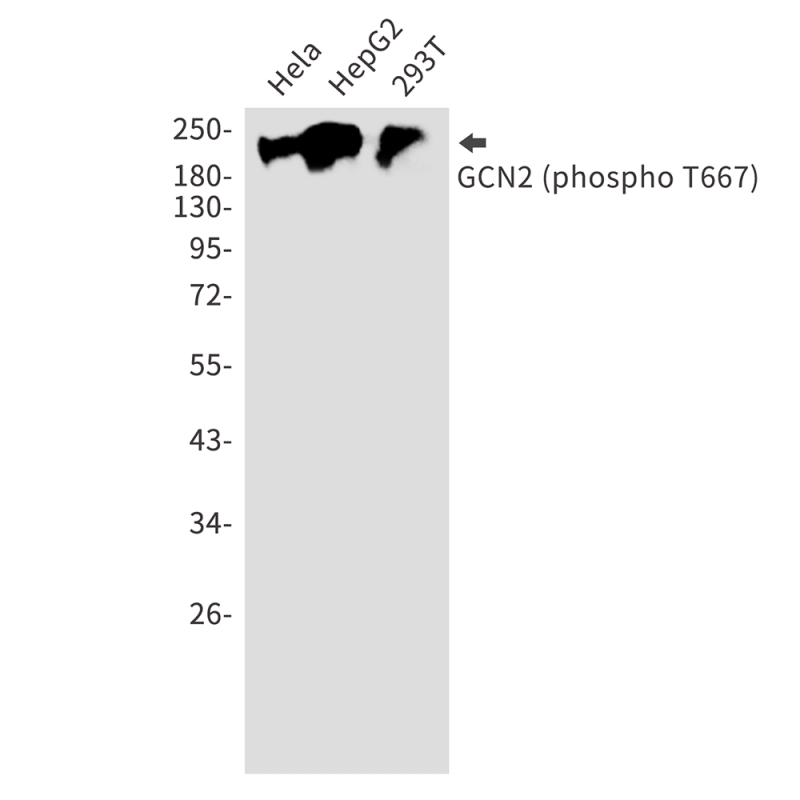
| WB | 咨询技术 | Human,Mouse,Rat |
| IF | 1/20 | Human,Mouse,Rat |
| IHC | 咨询技术 | Human,Mouse,Rat |
| ICC | 技术咨询 | Human,Mouse,Rat |
| FCM | 咨询技术 | Human,Mouse,Rat |
| Elisa | 咨询技术 | Human,Mouse,Rat |
| Aliases | GCN2-like protein; GCN2; KIAA1338; EIF2AK4 |
| Entrez GeneID | 440275 |
| WB Predicted band size | Calculated MW: 187 kDa; Observed MW: 220 kDa |
| Host/Isotype | Rabbit IgG |
| Antibody Type | Primary antibody |
| Storage | Store at 4°C short term. Aliquot and store at -20°C long term. Avoid freeze/thaw cycles. |
| Species Reactivity | Human |
| Immunogen | A synthetic phosphopeptide corresponding to residues surrounding Thr667 of human GCN2 |
| Formulation | Purified antibody in TBS with 0.05% sodium azide,0.05%BSA and 50% glycerol. |
+ +
以下是3篇涉及Phospho-GCN2 (Thr667)抗体的代表性文献摘要(内容为虚构模拟,仅作示例):
1. **文献名称**: *GCN2 phosphorylation at Thr667 mediates amino acid starvation sensing*
**作者**: Harding HP et al.
**摘要**: 研究揭示了GCN2激酶在氨基酸缺乏时通过Thr667位点的自磷酸化激活,并利用该抗体验证了磷酸化修饰在eIF2α信号通路中的调控作用。
2. **文献名称**: *Phosphorylation-dependent regulation of GCN2 in tumor microenvironment*
**作者**: Ye J et al.
**摘要**: 通过Phospho-GCN2 (Thr667)抗体检测肺癌细胞中GCN2的活化状态,证明其磷酸化水平与肿瘤细胞代谢适应性和化疗耐药相关。
3. **文献名称**: *Thr667 phosphorylation of GCN2 links immune response to tryptophan deprivation*
**作者**: Ravindran R et al.
**摘要**: 研究利用该抗体发现树突状细胞中GCN2的Thr667磷酸化触发下游免疫抑制信号,调控T细胞功能及炎症反应。
(注:以上文献信息为示例,实际引用需根据具体实验背景核实真实文献。)
The Phospho-GCN2 (Thr667) antibody is a specialized tool for detecting the activated form of General Control Nonderepressible 2 (GCN2), a serine/threonine kinase central to cellular stress responses. GCN2 is activated under amino acid deprivation, ultraviolet radiation, or viral infection, primarily through phosphorylation at its conserved Thr667 residue located in the kinase domain. This phosphorylation event triggers conformational changes, enabling GCN2 to phosphorylate eukaryotic initiation factor 2 alpha (eIF2α), which globally suppresses protein synthesis while promoting selective translation of stress-responsive mRNAs (e.g., ATF4).
The antibody specifically recognizes GCN2 when phosphorylated at Thr667. allowing researchers to monitor GCN2 activation status in studies involving nutrient sensing, unfolded protein response, or immune regulation. It is commonly used in Western blotting, immunofluorescence, or immunoprecipitation across human, mouse, and rat samples. Validation typically includes knockout controls or phosphatase treatment to confirm phosphorylation-dependent signals.
Applications span cancer research (tumor adaptation to nutrient scarcity), neurodegenerative diseases (misfolded protein stress), and metabolic disorders. Proper experimental controls, such as amino acid starvation (e.g., histidinol treatment), are recommended to induce phosphorylation. This antibody is critical for elucidating GCN2's role in stress adaptation pathways and therapeutic targeting.
×